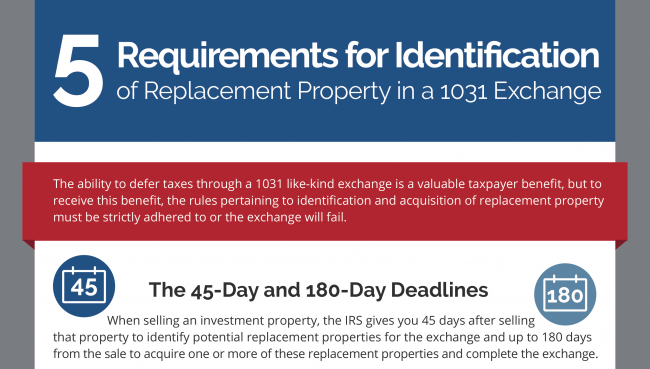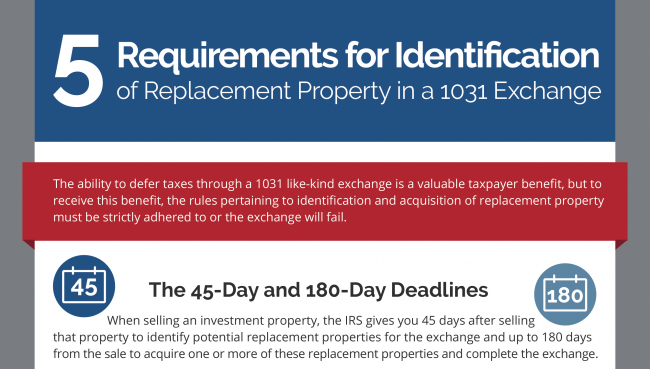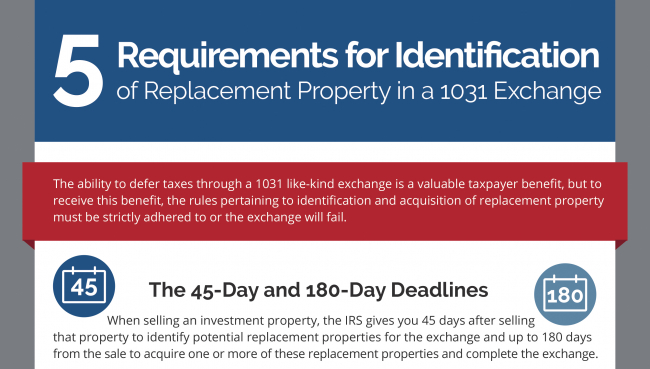How is your property titled?
When considering selling your investment property it is required that you know how your property is owned/titled, or said differently, the tax identity. Prior to even listing your investment condo, single family rental home, vacant land, or even your farm, your Realtor(R) will need to know “who truly owns this property”? A 1031 like-kind exchange only works when the owner of the property being exchanged for replacement property is the same as the owner for the relinquished property.
How is your property owned for tax purposes?
Often, owners of investment property assume that the rental home, land, or building is in their name as individuals. Or perhaps along with their spouse. If the property was inherited years ago from a distant family member, are you sure you know how the property is now being held? Was it part of a Marital or Family Trust? Or perhaps your relative left you 50% ownership in a Tenants in Common structure. Was the property transferred to a new LLC structure with a completely different name than your surname?
In addition, some types of ownership are disregarded for tax purposes. For instance, one of the relinquished and replacement properties might be titled differently, but may still be the same for tax purposes. Examples include the taxpayer individually, the taxpayer owning through his/her living trust, the taxpayer holding in a single member LLC, a married couple living in a community property state holding a two member LLC, and the beneficiary of a land trust. All of these are interchangeable and for tax purposes do constitute the same taxpayer. More on this follows below.
What is the best way to check how your property is held?
Most of the time, it is relatively easy and typically free, to find out how your property is titled. The first way to do so, is to check with your local Tax Assessor’s or Recorder of Deeds official website and search the property address. The tax records may show who or what tax entity is responsible for paying the taxes on the property. Information from the Recorder of Deeds might show the most recent “deed of record”. Another option might be a title search done on the property from a local title company. These searches are very inexpensive and working with a title company is well worth the investment to ensure your property is accurately described prior to listing with a broker and prior to engaging in a 1031 exchange.
Most Common Ways to Hold Title
In addition to who might hold title there are numerous ways to hold title of property, but a few of the most common ways in which to hold title, with specific consideration to a 1031 exchange include the following:
Fee Title
When the taxpayer holds the title under their name, or a combination of names, such as their name in addition to their spouse’s name, the property is considered held in Fee Title (sometimes called fee simple). For example, the investment property might be titled under John Doe and Jane Doe. Fee simple is the most common form of ownership and the fullest way property can be held. Some lesser holdings for example might be a tenant under a long term lease, the holder of a property easement, a life estate, etc.
Limited Liability Company (LLC)
A property could also be titled under an LLC, which could be a single member or multi-member LLC. LLCs are very common for real estate investments because they limit the member’s liability to the value of the asset(s) owned by the LLC and not beyond. A single member LLC is taxed to the individual, whereas a multi-member LLC requires an EIN as a partnership, and it reported on an IRS Form 1065 with K-1s being sent to the members to report on their personal return. In a 1031 exchange, a single member LLC can acquire real estate via an assignment of membership interest.
Revocable “Living” Trust and Land Trusts
Also known as a Living Trust, Grantor Trust, or Self Declaration of Trust, a Revocable Trust is a common way to hold title in which an individual transfers their asset(s) into a Trust to control it while living, and upon death the asset(s) goes to the individual(s) named in the Trust. The owner of the Trust can revoke or change it at any time while living, hence the name “Revocable Trust”. A Land Trust is also common, and is simply a Living Trust with the only asset being real estate and the Trustee often is a corporate land trust company. A Land Trust uses a simple form provided by the land trust company and provides a simple way to control and pass ownership of real estate. Land Trusts are particularly common in states such as Illinois, Florida, Indiana and Hawaii as well as some others.
Subchapter S-Corp
Another common way in which real estate property is held is a Subchapter S-Corp, which provides liability protection for the investor and is reported on the taxpayer’s own tax return. It is very difficult to change to individual ownership and therefore it is not recommended when a 1031 exchange is a consideration.
Less Common Ways to hold Title
Other Trusts
Less common than the Revocable or Living Trust, is the Irrevocable Trust, which as its name implies, means that it cannot be changed once it is in place. Irrevocable Trusts are sometimes used to protect assets and for tax purposes.
Some other types of Trusts that can hold title include: Testamentary Trust, which arises under an individual’s will, and rather than giving the person who inherits the asset and outright ownership, this trust is established to hold the person’s interest; The Living Trust may contain terms that provide upon death of the person, two types of Trusts “spring” into being. The first of these is the Martial Trust, commonly used in estate planning to set up a trust upon death under the Living Trust for the surviving spouse; The other Trust that comes into being upon the death of the person owning the Living Trust is known as a Family Trust, where the assets are funded into the trust and split with the Marital Trust according to a formula. Typically, the Marital Trust receives the maximum amount that would not be subject to tax and the balance goes into the Family Trust. These kinds of Trusts also effectively double the amount that a couple could pass onto the heirs without taxation.
Types of Tenancies
Tenants by the Entirety
Another form of ownership for married couples is Tenants by the Entirety, which is limited to spouses and in most states is limited to the residence of the spouses. Just like with Joint Tenants it provides “rights of survivorship” to the owners. It can only be broken by death, divorce, or a mutual agreement. The primary difference between this holding versus joint tenancy is that the property is exempt from being attached by judgement creditors of either spouse. An example would be a doctor who has the potential for malpractice claims.
Tenants in Common (TIC or Tenancy in Common)
Real estate can also be held as Tenants in Common by which each owner owns a fractional interest in the whole asset and upon death the interest is passed through the owner’s estate. Additionally, each owner may transfer his or her interest in the asset without regard to the plans of the others. This is useful when two or more investors own a property together, and not all wish to participate in an exchange or do not wish to all acquire the same replacement property.
Joint Tenants (Joint Tenancy)
Joint Tenants own an undivided interest in the whole property and each owner is given “rights of survivorship”. This type of ownership is common amongst spouses and other familial relations.
Type of Ownership Granted By Deeds
There are a handful of ways in which you can title real estate ownership through deeds, such as:
Warranty Deed: The seller warrants to the buyer that he/she is passing good title for all past purposes. In the event there turns out to be matters adversely effecting title, the recipient of the Warranty Deed can go back to the seller since the deed “warranted” that title was clear, but in this modern era going back to the seller is very uncommon as title insurance provides easier and better protection.
Special Warranty Deed: The seller warrants to the buyer that he/she is passing title free of defects during the seller’s period of ownership only and not before.
Quit Claim Deed: The seller is making no representation as to the status of the title, rather the seller is saying “Whatever I have I am giving to you as-is.”
Series LLCs
Series LLCs allow for sub-LLCs to be held under a parent LLC. This is a less expensive method than opening separate LLCs for each separate property, but still provides protection to the taxpayer who owns multiple properties and wishes to separate them for liability reasons. Series LLCs are state specific; not all 50 states have them.
C-Corporation
A C-Corporation is a conventional corporation with its own tax reporting, it is not typically used for real estate investors.
Why is Ownership so important for a 1031 like-kind exchange?
Timing is everything. When inventory is tight, buyers and sellers both want to move fast. Under a 1031, the Qualified Intermediary will require exchange agreements and assignments to be executed BEFORE closing. Having all documentation correctly identifying who owns the property will ensure a closing can occur not only on time, but also without last minute changes to the agreement, assignments, checks, etc. Updating seller information last minute will postpone closing, increase fees, and at times, cause the buyers to back out if dates are not adhered to.






